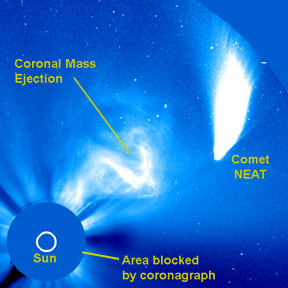Comet NEAT as seen by SOHO on 18 February 2003.
Click on image for full size
Image courtesy NASA
Comet NEAT passes Sun
News story originally written on February 20, 2003
The comet shown in this picture is so neat that scientists named
it Comet NEAT! Actually, this comet was discovered by NASA's Near Earth Asteroid Tracking (NEAT) program,
so that is the real reason it is called Comet NEAT.
This time NEAT found a comet instead of an asteroid.
Comet NEAT (which is also called Comet C/2002 V1) was discovered in November 2002.
This picture was taken by a spacecraft called SOHO.
When the SOHO spacecraft took this picture, we couldn’t see Comet NEAT
from Earth because the comet was too close to the Sun.
SOHO has a special instrument called a coronagraph which blocks the brightest light from the Sun.
A coronagraph is a lot like a solar eclipse
in the way it blocks the Sun's light
Comets are made mostly of ice. When a comet gets near the Sun, the heat from the Sun makes some of the ice melt.
Scientists like to study comets that are close to the Sun to see how the
comets change as they melt. This picture also shows a
Coronal Mass Ejection (CME). A CME is a huge explosion on the Sun.
Scientists want to learn what a big explosion does to a comet when it is this close to the Sun.
You might also be interested in:

An eclipse of the Sun occurs when the Earth passes through the Moon's shadow. A total eclipse of the Sun takes place only during a new moon, when the Moon is directly between the Sun and the Earth. When
...more
It was another exciting and frustrating year for the space science program. It seemed that every step forward led to one backwards. Either way, NASA led the way to a great century of discovery. Unfortunately,
...more
The Space Shuttle Discovery lifted off from Kennedy Space Center on October 29th at 2:19 p.m. EST. The weather was great as Discovery took 8 1/2 minutes to reach orbit. This was the United States' 123rd
...more
A moon was discovered orbiting the asteroid, Eugenia. This is only the second time in history that a satellite has been seen circling an asteroid. A special mirror allowed scientists to find the moon
...more
Will Russia ever put the service module for the International Space Station in space? NASA officials want an answer from the Russian government. The necessary service module is currently waiting to be
...more
A coronal mass ejection (CME) happened on the Sun early last month. The material that was thrown out from this explosion passed the ACE spacecraft. The SWICS instrument on ACE has produced a new and very
...more
J.S. Maini of the Canadian Forest Service called forests the "heart and lungs of the world." This is because forests filter air and water pollution, absorb carbon dioxide, release oxygen, and maintain
...more















